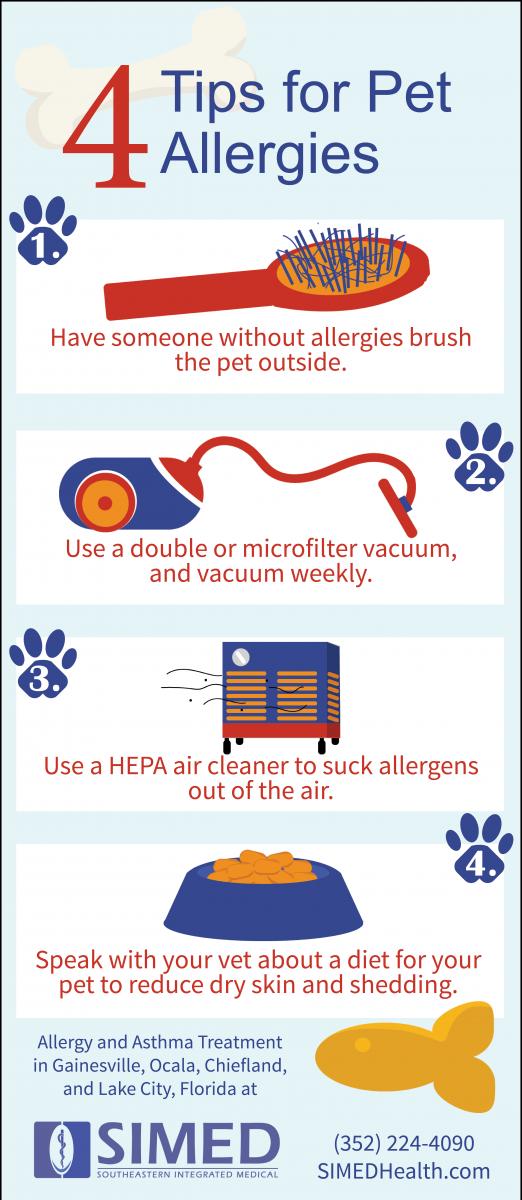
February 20th is National Love Your Pet Day, a day to celebrate and appreciate your furry friends. But what happens when our furry best friends make our eyes water, our skin itch, and our chest tighten?
With the help of SIMED Gainesville Allergy and Immunology physician Dr. Belen Tan and the American Academy of Allergy, Asthma & Immunology, we were able to answer your questions about pet allergies, including how to tell if you’re allergic to your pet and how to treat your allergies.
How common are pet allergies?
Millions of pet owners are allergic to their pets. While pet allergies in reptiles is rare, pet allergies are common among dogs, cats, rodents, and other animals with fur. About 10% of allergic individuals have allergies to pets. As many as one in five individuals with asthma are allergic to pets. People can also be allergic to birds.
How can I tell if I’m allergic to my pets?
Allergy testing by an allergist like those at SIMED’s Gainesville, Ocala, Chiefland, and Lake City locations is the best method to diagnose exactly what you are allergic to and help you figure out a plan.
If you get close to your pet and have more symptoms every time you’re around them, if you’re itching when you’re near your pet and your nose is runny or you’re sneezing and have other symptoms, you might be allergic to your pet.
Some people might not realize their symptoms are related to their pet because their symptoms are not as pronounced. You may have the symptom year round and not notice that it’s the culprit.
When your pets have access to the entire house, they fill the air with allergens. You can get accustomed to those allergens and not realize you have allergies. You could be allergic to pollen, weeds, and grass, but not notice because when your dog carries the allergens in after a walk, you continue to have symptoms indoors.
If your symptoms are so severe you need to find your pet a new home, the allergies could last for another 6 to 12 months after because the allergens are so light they stay in the air. It’s important to remember that symptoms continue after you leave the presence of the pet. Allergens can linger in the air, on furniture, on linens, on carpets, and on clothes.
What are the symptoms of pet allergies?
Sometimes the symptoms can be similar to hay fever.
Symptoms include:
- Sneezing
- Itchy, watery eyes
- Runny nose
- Congestion
- Itchy skin or raised, red patches (hives)
- Asthma symptoms like wheezing, difficulty breathing, and chest tightness
- Nasal congestion
If you experience any of these symptoms, you should get tested.
Why am I allergic to my pet? Will getting a hypoallergenic pet solve my problem?
People can be allergic to a pet’s dander, skin flakes, saliva, and urine. Pet hair or fur can also collect allergens, but people aren’t allergic to the pet fur itself.
Pet allergies occur year round and cause symptoms in the nose, throat, eyes, ears, skin, and roof of the mouth. There are no truly hypoallergenic breeds of dogs or cats because allergic dander in cats and dogs is not affected by length of hair or fur, nor by amount of shedding.
Some people may still do better with a dog or cat that has short hair or sheds less. Pets that are more easily bathed and enjoy baths might also be better for people with allergies.
What else can I do to help my pet allergies?
To help alleviate the symptoms of your pet allergies, you can:
1. Get tested and begin treatment
2. Try not to hug, kiss, or maintain close contact with your pet
3. Have someone without allergies brush the pet outside
4. Use a double or microfilter bag to vacuum
5. Use HEPA air cleaners (any air purifier should help as it sucks the allergens out of the air)
6. Remove carpeting and rugs
7. Speak with your vet about a balanced diet for your pet to prevent dry skin and excess shedding
8 Use covers on car seats if you travel with your dog
9. Keep your pet out of the bedroom
While you might be tempted to just put your animal outside, doing so will only cause a slight improvement. Dander will eventually find its way indoors on clothing or shoes.
Medications for Pet Allergies
If you have pet allergies, you could take antihistamines or other allergy medications to alleviate the symptoms. All antihistamines work differently on each pet owner so you might have to try a few to find one that fits for you.
Antihistamines can be divided into the newer, long-acting generation, like Claritin, Xyzal, Zyrtec, and Allegra, and older generations, like Benadryl and Chlor Trimeton. The new generation generally is preferred by most allergy patients because it is not as sedative as the old one.
Avoid driving when taking the older generation sedative antihistamines because, according to Florida Law, you can get a moving if you drive with the medication in your system.
Immunotherapy for Pet Allergies
If you continue to have symptoms, you can get immunotherapy. Most insurances cover immunotherapy completely, but for some insurance, there might be deductibles or a copay.
Immunotherapy involves desensitizing yourself to the allergies. There are different methods of immunotherapy. The gold standard is Subcutaneous Immunotherapy (SCIT). The newer type is Sublingual Immunotherapy.
The SCIT has been used for over 100 years and has been proven to work effectively. First, a person would receive shots every week to build-up the dose. The amount of shots and length of time for this step would vary depending on the person and the severity of their symptoms. After the first step is completed, the treatment would eventually be stretched out to one shot every month over a course of 3 to 5 years for maintenance. After going through the therapy, the individual would be tested again for allergies.
Sublingual Immunotherapy is newer, and it involves placing tablets or other solutions that contain allergens under your tongue to adjust to allergies. While the FDA has approved one for grass pollen and weed pollen and is in the process of approving one for dust mites, it has not approved similar drops for dander because they have not proven to be effective. Because pet allergy Sublingual drops have not been approved by the FDA, they are not covered by insurance and not administered by SIMED doctors.
What if none of the options above work?
Rehoming a pet can be a last resort, but if your allergies continue and you can’t handle them, you may need to find your pet a new home. Remember, it takes six or more months to get rid of the dander and relieve symptoms after the pet is gone.
Before parting with your pet, make sure to talk with your allergist about whether this is the best and only option for you. Your doctor understands the difficulty of parting with a loved pet and will work through every option with you to make sure you’ve exhausted all your resources.
We hope the information in this article will allow you to continue to love your pet without the side effects. Happy National Love Your Pet Day!
If you believe you might have pet allergies or another type of allergies, you can schedule an appointment with Dr. Tan or another SIMED Allergy and Asthma physician today. Call us at one of our offices:
Gainesville: (352) 331-3502
Ocala: (352) 547-1016
Chiefland: (352) 493-2305
Lake City: (386) 755-1651
Or request an appointment online today.